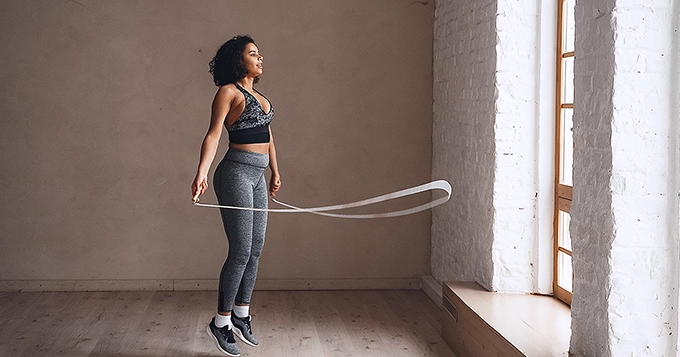Jumping rope, once a classic childhood activity, has recently regained popularity as a preferred fitness option. However, like any exercise, there are advantages and disadvantages to take into account. Let’s delve into the upsides and downsides of skipping rope to determine if it’s a suitable inclusion in your exercise regimen.
What are the Benefits of Jump Roping?
“What happens if you jump rope everyday?” is a question often asked by individuals curious about the potential effects of incorporating daily rope jumping into their fitness routine. The benefits of jump roping include:
- Portable and Affordable
A jump rope is a handy tool for on-the-go workouts because it is an easy-to-carry and reasonably-priced piece of equipment that can be used practically anyplace.
- Cardiovascular Health
If you are looking for an efficient way to get your heart pumping, jumping rope stands out as one of the top choices. It rapidly elevates your heart rate because it engages multiple muscle groups simultaneously.
The Centers for Disease Control and Prevention (CDC) categorizes jumping rope as a vigorous-intensity activity. In terms of health benefits, just one minute of vigorous-intensity activity is equivalent to about two minutes of moderate-intensity activity, such as brisk walking or playing doubles tennis. This means that by incorporating a jump rope workout into your routine, you can reap the same benefits as moderate-intensity exercise in about half the time.
- Calorie Burner
Jumping rope exercises are a highly efficient calorie-burning exercise, helping you torch calories and shed unwanted fat, making it an excellent addition to any weight loss program.
Jumping rope offers an efficient workout that can torch a significant number of calories in a brief period. For example, someone weighing 200 pounds (91 kilograms) can burn up to 241 calories in just a 20-minute session.
- Full-Body Exercise
Jump rope benefits your entire body. Jumping rope provides a comprehensive strength workout for your entire body. It involves engaging muscles from head to toe throughout the entire movement. Specifically, it targets your lower body, including your calves, quads, hamstrings, and the muscles in your feet and ankles. Additionally, it works your core, biceps, and shoulders.
What’s particularly impressive is that you don’t need to consciously focus on activating all these muscle groups simultaneously while jumping. It tends to occur naturally as you perform the exercise
- Improved Coordination
Jumping rope demands significant coordination. You’ll work on timing and need mental focus. Your hands, feet, and sometimes even your eyes must synchronize to swing the rope correctly, time your jumps accurately, and maintain a steady rhythm. Jumping rope, being a repetitive activity, necessitates maintaining a consistent rhythm and complete coordination across your entire body.
While mastering this coordination can initially seem daunting, consistent practice leads to noticeable improvements. As you progress, you’ll gain the ability to tackle new footwork patterns and tricks with the rope, injecting a sense of freshness and enjoyment into your workout routine.
- Bone Density
Jump rope benefits not just your muscles but also your bones.
As you age, your bone density tends to decline, increasing the risk of conditions such as osteoporosis and osteomalacia, as well as the likelihood of bone fractures. However, engaging in high-impact exercises like jumping rope can help combat these risks. Similar to muscles, bones are living tissues that respond to exercise by becoming stronger.
A study conducted in 2015 on premenopausal women demonstrated the benefits of jumping rope for bone health. Participants who performed 10 or 20 jumps with 30 seconds of rest between jumps, twice daily for 16 weeks, experienced improvements in hip bone mineral density compared to the control groups.
Consult your doctor before adding high-impact exercises like jumping rope to your routine, especially if you have osteoporosis. While jumping rope can be beneficial for bone density, it may pose risks for weakened bones.
- Increases Agility
Mastering proper jump rope form entails moving from the balls of your feet, which not only enhances footwork and agility but also translates seamlessly to sports requiring rapid changes in direction. This skill is particularly advantageous in sports like boxing, basketball, and volleyball, where quick directional shifts are crucial.
- Trains Power
After mastering the basic jump rope technique, you can challenge yourself further by learning advanced moves like the double under. Performing a double under requires a more forceful and higher jump, making it an excellent way to enhance explosive power. This increased power can be particularly beneficial in sports like volleyball, where the ability to execute vertical jumps effectively is essential.
- Can be Meditative
While jumping rope may seem intense, it can also serve as a deeply meditative activity. As you begin jumping rope, you naturally find your rhythm, entering a state of flow where you can lose yourself entirely.
It acts as a form of active meditation, enabling you to concentrate solely on maintaining a steady rhythm without distraction. Additionally, you can turn it into a mindfulness exercise by closing your eyes and dedicating 30 seconds to attentively listening to the sound of the rope or other sensations in your environment.
Drawbacks of Jumping Rope
Now, you’ve discovered the benefits of jumping rope. However, while it is an excellent form of exercise with numerous benefits, it also comes with some potential drawbacks:
1. Impact on Joints
Doing jump rope everyday could be taxing to your joints.
Jumping rope involves repetitive impacts on the joints, particularly the knees, ankles, and hips. This can lead to strain or injury over time, especially if proper form is not maintained or if the surface on which you’re jumping is unforgiving, like concrete.
2. Risk of Injury
Incorrect technique or overdoing it can lead to injuries such as shin splints, tendonitis, or stress fractures. Beginners, in particular, may struggle with coordination and timing, increasing your risk of tripping and falling.
3. Not Suitable for Everyone
Individuals with certain pre-existing conditions such as knee or ankle problems, osteoporosis, or balance issues may find jumping rope too high-impact or risky. It may also be unsuitable for individuals with severe obesity due to joint stress.
4. Limited Muscle Engagement
While jumping rope is a great cardiovascular exercise and can help tone muscles in the legs and core, it doesn’t engage the upper body muscles as effectively. Thus, it may not provide a balanced full-body workout on its own.
5. Boredom and Plateau
The repetitive nature of jumping rope may lead to boredom and plateauing in fitness progress for some. It’s important to vary workouts to keep motivation high and continue challenging the body.
6. Space and Equipment Requirement
Unlike some other forms of exercise, jumping rope requires a sufficient amount of space and the right equipment (a proper rope of appropriate length). This may not always be available or convenient, especially for those who travel frequently.
7. Difficulty for Beginners
Jumping rope requires coordination, timing, and rhythm, which can be challenging for beginners. Developing the necessary skills and endurance to jump consistently for extended periods may take time.
8. Potential for Overuse Injuries
Jumping rope is a high-impact exercise, but doing it too frequently or for prolonged periods without adequate rest can lead to overuse injuries. To avoid overtraining, it’s essential to incorporate rest days into your workout routine and listen to your body’s signals.











